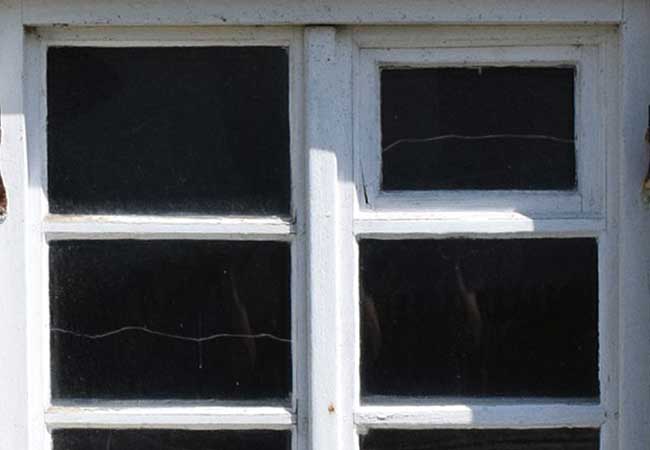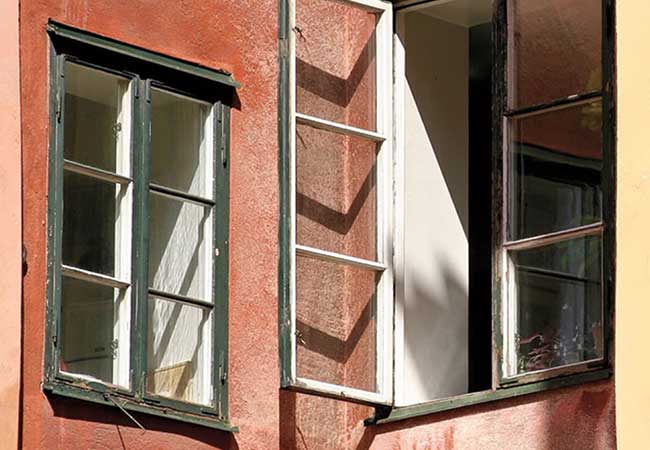What causes a thermal stress crack in windows? And other common questions.
Why do windows fog or crack? What do you do if a wood window gets stuck? We’ve compiled our answers to your most common window questions.

KEY TAKEAWAYS
- Foggy windows often result from seal failure in older windows, allowing moisture between panes, while cracked windows can be caused by thermal stress, impact, or pressure changes.
- Thermal stress cracks occur due to rapid temperature changes or shading differences, especially in large windows on shaded or recessed walls, and are more common during seasonal transitions.
- While stress cracks are difficult to prevent, using thicker glass or selecting climate-appropriate features may help; if a crack occurs, contact a local Pella representative for replacement options.
Window challenges can be frustrating, but the experts at Pella Windows and Doors are here to answer your questions about some of the most common window difficulties.
Three Common Window Questions
Foggy windows, cracked windows and stuck windows all present challenges to homeowners. Read on to understand why these issues occur and what you can do to prevent them.
Why do windows fog?
No homeowner enjoys foggy windows. Condensation on the interior or exterior of a window is often an indication of high humidity levels and is nothing to worry about. Condensation between panes of insulating glass, however, can develop when the seal between panes of glass fail and allows moisture to leak in. This typically occurs in older windows or doors. It’s not uncommon to walk into older homes and see windows on the sunny side of the home that have condensation and fogging between the panes. This same fogging can occur on any side of the home but is generally more prevalent on the sunny sides because the additional heat from the sun tends to accelerate the seal failure.
Making the right window choice when purchasing replacement windows and doors can help ensure your windows look great for years.
“Choosing and investing in a quality glass system is an important decision in buying new or replacing old windows,” says Pella Corporation engineer Aaron Ryan. “Our windows and doors are tested for quality and include insulating glass to lower energy bills, reduce fading damage to interior fabrics and provide a more comfortable home.”
In state-of-the-art product-testing facilities, Pella subjects windows to harsh conditions — the burning rays of the sun, salt air, acid rain, excessive humidity, extreme heat and cold, high wind and driving rain. These stringent measures help ensure that Pella windows have the quality homeowners expect.

Why do windows crack?
Another frustrating window challenge homeowners experience is cracked windows. Sometimes it is obvious why a window cracked. Perhaps someone or something hit your window at high impact, but other times you might be left scratching your head as to what could have possibly caused such a crack to appear. In that case, it is likely a stress crack.
Engineers at Pella recognize three general types of glass cracks:
- Thermal stress crack — cracks at a perpendicular angle. May be caused by sudden temperature swings or shading changes on a building.
- Impact crack — cracks in a starburst pattern that radiates from a central point. Hitting a window with a baseball or golf ball could result in an impact crack.
- Pressure crack — cracks in a pattern similar to the curve of an hourglass. Insulating glass — windows with two panes of glass that have air inside them — may get pressure cracks if they are installed at too high or too low of an elevation level or if there are drastic pressure system changes in the weather.
What is a stress crack?
Imagine pouring cold water into a baking dish you just pulled out of the oven. Not the smartest thing to do, we know, but it is a good example of how thermal stress can crack a window. Think about stress cracks like this: As the cold liquid touches the hot dish, there’s an uneven increase in the thermal expansion of the walls of the baking dish. If the expansion is significant enough and the dish is thin or compromised by a nick or weak spot, the baking dish may break.
Now think about your windows and where they are located on your home.
Stress cracks occur more often in large windows that are located on a shaded or recessed wall. The shadows created by these locations set up a quickly changing stress factor between glass that is in the sunny, warmer area and glass that is in the cooler, shaded area. If the stress gets to be too much, from the glass expanding in the heat or shrinking in the cold, it can crack.
“Stress cracks are often a function of the architectural design of the building as much as the glass in your window,” says Bruce Baier, director of product engineering at Pella Corporation.
“They tend to show up more in newly installed windows than in older windows. But stress cracks are not necessarily time-related. It may have more to do with the shading of your home.”
Common causes for stress cracks
If the wind blows down a large shade tree in your yard or a new house goes up next door, it could change the amount of shade on your window and create conditions for thermal stress cracks. Seasonal factors, like dramatic overnight temperature changes, are a common cause of stress cracks as well.
“We receive more customer calls about stress cracks in the spring and fall, when areas are experiencing hot temperatures during the day and then much cooler temperatures at night,” says Faye Howard, customer support at Pella. “It’s often a seasonal factor.”
Identifying stress cracks
Thermal stress cracks in windows are easy to identify because they start perpendicular to the glass edge. “It’s easy to identify a stress crack if you can see the edge of your glass,” adds Howard. “The crack will extend about a half-inch straight away from the glass edge.”
But that’s only true of the first half-inch of the crack, after that it may spider in any direction. It’s worth noting that windows with cladding or trim may obscure your view of the glass edge.
Can I prevent stress cracks?
The short answer is: not really. Stress cracks are a naturally occurring result of expanding and contracting glass due to temperature changes. However, installing thicker glass and choosing glass features based on your climate and sun exposure needs may help decrease your risk.
In existing homes, installing thicker, stronger replacement panes of glass — 4mm glass instead of the standard 3mm glass — can help prevent stress cracks. For home additions or new construction projects, work with your architect to best dictate sun exposure on your windows.
Pella offers several glass options, ranging from tinted insulating glass and tempered insulating glass to impact-resistant insulating glass and laminated insulating glass.
“Heat-strengthened glass and tempered glass are very similar,” Baier says. “Both are heated and quenched (cooled) similar to steel, just at different temperatures or rates. Tempered glass is stronger, and typically costs more.”
How do I fix a stress crack?
If you discover a stress crack in your windows, connect with your local Pella representative for assistance in replacement of the glass and/or the window as needed.

Why is my window stuck?
There are a few things that can cause a wood window to swell and stick — wet weather or excess paint being two of the biggest culprits. Dirt, dust and pollen built up in the track of your operable window can be another cause for a sticky or hard-to-open window. Always double-check to make sure your window is meant to open. It may be that particular window in your home is a fixed window or has been sealed shut for energy-efficiency or security reasons.
How can I open a stuck window?
Here are a few ways you can pry a stuck window loose:
- If you suspect humidity to be at fault: Start by aiming a hairdryer set to low heat at the sash along the window frame on either side until the swelling goes down a bit, then carefully work the window free.
- If you think it’s a paint issue: Carefully slide a craft or utility knife between the window sash and the stop to break the paint seal.
- If you think you need to clean your window tracks: Start by wiping the tracks clean with a cloth, then vacuum any debris from the window tracks. Use a cloth dipped in a mild cleaning solution to remove any heavy buildup then dry the tracks completely with a clean towel.


